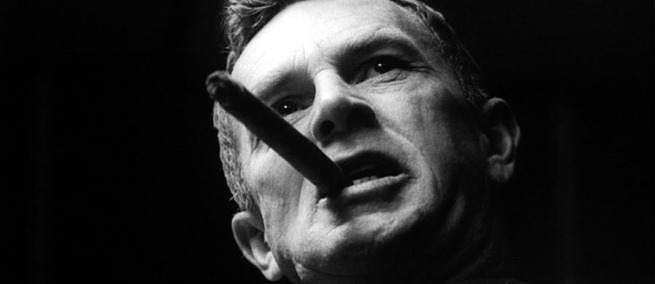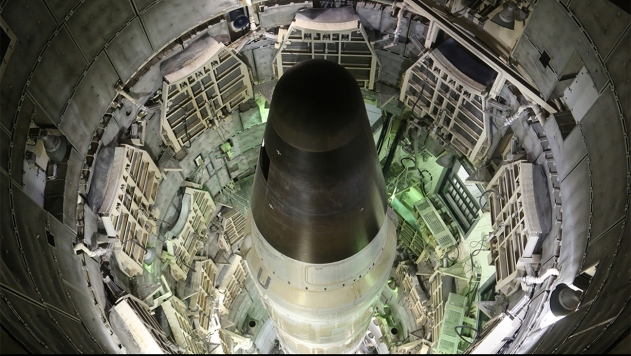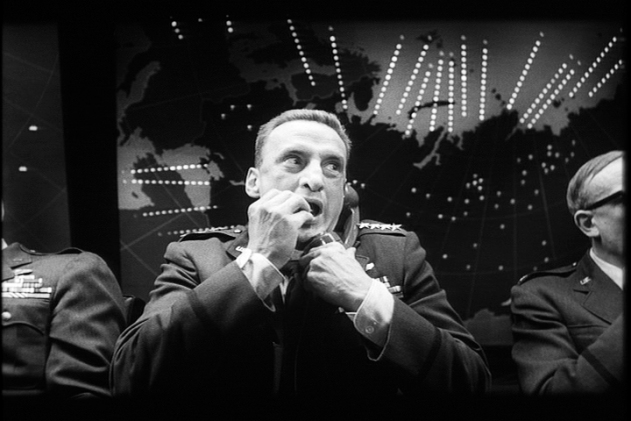
Who knows America’s nuclear code? How is the decision to detonate a nuclear weapon made? In DR. STRANGELOVE, Stanley Kubrick presents a hysterical war room and a broken chain of command which sets off a nuclear attack. Robert Kenner’s new documentary COMMAND AND CONTROL stresses the fallibility of technology, of which nuclear weapons are no exception. Neither of these films is reassuring. Taken together, they are a chilling reminder of what can go wrong. There are currently 15,000 nuclear weapons in the world.
In 1980, in Damascus, Arkansas, a mechanic working in a missile launch facility dropped a tool causing highly explosive rocket fuel to begin leaking. The facility was a silo which contained a missile ready to launch the most powerful nuclear warhead the United States had—more powerful than both atomic bombs. A similar event occurred in 2014. These human errors are the subject of Eric Schlosser’s new book Command and Control and the former event the focus of Kenner’s documentary.

On September 7, Museum of the Moving Image presented a screening of Kubrick’s 1963 DR. STRANGELOVE introduced by Eric Schlosser. According to Schlosser, the United States went from having 150 nuclear weapons at the start of the Cold War to more than 30,000 during the Johnson administration. Schlosser questioned former Secretary of Defense Robert McNamera about this surge who said, “each step seemed perfectly logical at the time, and step by step by step, led to a place of total madness.”
Science & Film spoke with COMMAND AND CONTROL director Robert Kenner on the phone. Kenner said DR. STRANGELOVE is “this great satire that happens to be so factually accurate. It got attacked by the Air Force at the time, but so much of it was true.”
According to Schlosser, speaking at Museum of the Moving Image, during the Cold War the United States put nuclear weapons on Air Force bombers and had those bombers in the air near the Soviet Union, “ready to attack the moment that bombs and missiles started falling on the United States. The theory was: bombers in the air can’t be destroyed by Soviet weapons that hit American air bases. In order for this to work, you had to delegate the authority to use nuclear weapons to lower level commanders. Under the law, the only person who is allowed to authorize a nuclear strike in the United States is the President, but there was this concern in the late 1950s–what happens if the President is killed in a surprise attack? So, various levels of military authority were given the ability to start a nuclear war on their own if the United States had been attacked.” Thus, Stanley Kubrick’s Plan R and Sterling Hayden’s character, General Ripper, who sets the plan in motion.

There are striking similarities between Kubrick’s black comedy and Kenner’s documentary. Each film centers on “complex technical systems” and each shows how easily something can go wrong—Kenner said, “someone made a simple mistake in our movie, and in DR. STRANGELOVE someone had a mental breakdown.” According to Kenner, COMMAND AND CONTROL is a “techno-thriller” which could get people “to start thinking about the thing we stopped thinking about, which is the incredible power of these weapons and the fact that they’re not as secure as we think. You wonder what part of our population even knows that we have them. It’s pretty scary. When I was growing up there was a big anti-nuke movement—there were 70,000 weapons at the time—and looking at the [event] in Damascus it doesn’t make you feel more comfortable knowing there are 70,000 possible mistakes that could happen. But, this anti-nuke movement really helped our leaders think about the insanity of having all these weapons. Ronald Reagan and [Mikhail] Gorbachev went to work and cut them down to today’s 15,000. I would personally question whether we want to have 15,000. I am not going to answer whether we should have them or not, but it doesn’t make me feel safe knowing we have hydrogen weapons on the Syrian border in Turkey during a coup where the power is cut off to the base.”
COMMAND AND CONTROL was filmed in a missile silo in Arizona of the same kind in which the Damascus accident occurred. To make the film, Kenner said, “we did interviews, created the script, and then came up with the images both from archival and from this amazing location that enabled us to go make a thriller.” The film was made for PBS’s The American Experience and opened theatrically at Film Forum on September 14. Other cities will follow.